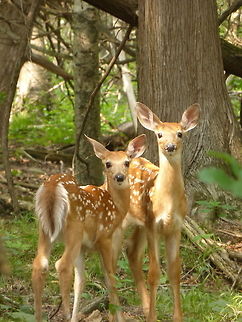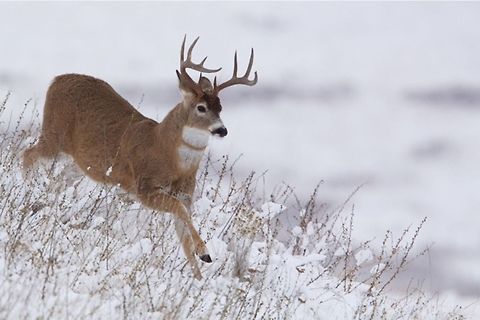
Appearance
The white-tailed deer's coat is a reddish-brown in the spring and summer, and turns to a grey-brown throughout the fall and winter. The white-tailed deer can be recognized by the characteristic white underside to its tail. It raises its tail when it is alarmed to warn the predator that it has been detected.An indication of a deer's age is the length of the snout and the color of the coat, with older deer tending to have longer snouts and grayer coats.
A population of white-tailed deer in New York is entirely white except for the nose and hooves – not albino – in color. The former Seneca Army Depot in Romulus, New York, has the largest known concentration of white deer. Strong conservation efforts have allowed white deer to thrive within the confines of the depot.
The white-tailed deer's horizontally slit pupil allows for good night vision and color vision during the day. Whitetails process visual images at a much more rapid rate than humans and are better at detecting motion in low-light conditions.
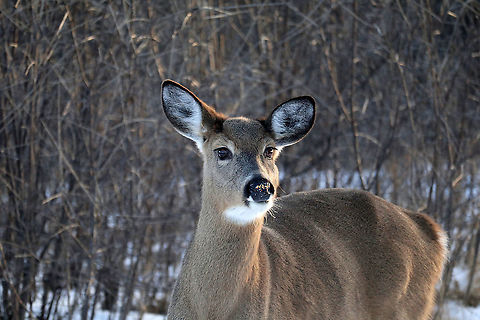
Distribution
The white-tailed deer population in North America has declined by several million since 2000, but as of 2017 is considered healthy and is approximately equal to the historical pre-colonization white-tailed population on the continent. The species has rebounded considerably after being overhunted nearly to extinction in the late 1800s and very early 1900s. By contrast, the species' closest cousins have seen their populations cut by more than half in North America after peaking in 1960 and have never regained their pre-colonization numbers. In the 21st century, the loss of natural predators has been more than offset by the ongoing loss of natural habitat to human development, and changes to logging operations.Several methods have been developed to curb the population of white-tailed deer in suburban areas where they are perceived as overabundant, and these can be separated into lethal and nonlethal strategies. Most common in the U.S. is the use of extended hunting as population control, as well as a way to provide meat for humans. In Maryland and many other states, a state agency sets regulations on bag limits and hunting in the area depending on the deer population levels assessed. Hunting seasons may fluctuate in duration, or restrictions may be set to affect how many deer or what type of deer can be hunted in certain regions. For the 2015–2016 white-tailed deer-hunting season, some areas allowed only the hunting of antlerless white-tailed deer. These included young bucks and females, encouraging the culling of does which would otherwise contribute to increasing populations via offspring production.
A more targeted yet more expensive removal strategy than public hunting is a method referred to as sharpshooting. Sharpshooting can be an option when the area inhabited by the deer is unfit for public hunting. This strategy may work in areas close to human populations, since it is done by professional marksmen, and requires a submitted plan of action to the city with details of the time and location of the action, as well as number of deer to be culled. Another controversial method involves trapping the deer in a net or other trap, and then administering a chemical euthanizing agent or extermination by firearm. A main issue in questioning the humaneness of this method is the stress that the deer endure while trapped and awaiting extermination.
Nonlethal methods include contraceptive injections, sterilization, and translocation of deer. While lethal methods have municipal support as being the most effective in the short term, some opponents of this view suggest that extermination has no significant impact on deer populations. Opponents of contraceptive methods point out that fertility control cannot provide meat and proves ineffective over time as populations in open-field systems move about. Concerns are voiced that the contraceptives have not been adequately researched for the effect they could have on humans. Fertility control also does nothing to affect the current population and the effects their grazing may be having on the forest plant make-up.
Translocation has been considered overly costly for the little benefit it provides. Deer experience high stress and are at high risk of dying in the process, putting into question its humaneness. Another concern regarding translocation is the possible spreading of chronic wasting disease to unaffected deer populations and concerns about exposure to human populations.
In addition to the danger of deer-vehicle collisions the National Agricultural Statistics Service reported that the estimated loss in field crops, nuts, fruits, and vegetables in 2001 was near $765 million.
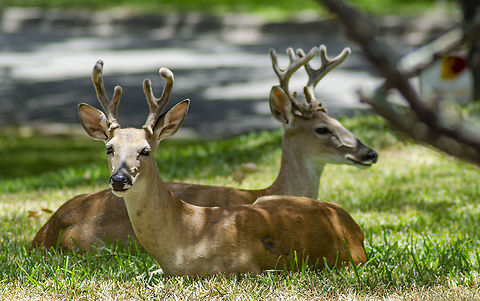
Behavior
Males compete for the opportunity of breeding females. Sparring among males determines a dominance hierarchy. Bucks attempt to copulate with as many females as possible, losing physical condition, since they rarely eat or rest during the rut. The general geographical trend is for the rut to be shorter in duration at increased latitude. Many factors determine how intense the "rutting season" will be; air temperature is a major one. Any time the temperature rises above 40 °F, the males do much less traveling looking for females, else they will be subject to overheating or dehydrating. Another factor for the strength of rutting activity is competition. If numerous males are in a particular area, then they compete more with the females. If fewer males or more females are present, then the selection process will not need to be as competitive.White-tailed deer have many forms of communication involving sounds, scent, body language, and marking. In addition to the blowing as mentioned above in the presence of danger, all white-tailed deer can produce audible noises unique to each animal. Fawns release a high-pitched squeal, known as a bleat, to call out to their mothers. This bleat deepens as the fawn grows until it becomes the grunt of the mature deer, a guttural sound that attracts the attention of any other deer in the area. A doe makes maternal grunts when searching for her bedded fawns. Bucks also grunt, at a pitch lower than that of the doe; this grunt deepens as the buck matures. In addition to grunting, both does and bucks also snort, a sound that often signals an imminent threat. Mature bucks also produce a grunt-snort-wheeze pattern, unique to each animal, that asserts its dominance, aggression, and hostility. Another way white-tailed deer communicate is through the use of their white tail. When spooked, it will raise its tail to warn the other deer in the immediate area.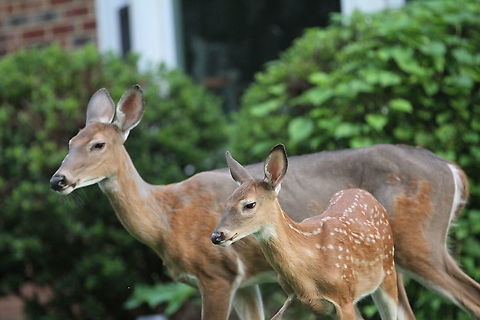
Habitat
White-tailed deer are generalists and can adapt to a wide variety of habitats. The largest deer occur in the temperate regions of North America. The northern white-tailed deer, Dakota white-tailed deer, and northwest white-tailed deer are some of the largest animals, with large antlers. The smallest deer occur in the Florida Keys and in partially wooded lowlands in the Neotropics.Although most often thought of as forest animals depending on relatively small openings and edges, white-tailed deer can equally adapt themselves to life in more open prairie, savanna woodlands, and sage communities as in the Southwestern United States and northern Mexico. These savanna-adapted deer have relatively large antlers in proportion to their body size and large tails. Also, a noticeable difference exists in size between male and female deer of the savannas. The Texas white-tailed deer, of the prairies and oak savannas of Texas and parts of Mexico, are the largest savanna-adapted deer in the Southwest, with impressive antlers that might rival deer found in Canada and the northern United States. Populations of Arizona and Carmen Mountains white-tailed deer inhabit montane mixed oak and pine woodland communities. The Arizona and Carmen Mountains deer are smaller, but may also have impressive antlers, considering their size. The white-tailed deer of the Llanos region of Colombia and Venezuela have antler dimensions similar to the Arizona white-tailed deer.
In some western regions of North America, the white-tailed deer range overlaps with those of the mule deer. White-tail incursions in the Trans-Pecos region of Texas have resulted in some hybrids. In the extreme north of the range, their habitat is also used by moose in some areas. White-tailed deer may occur in areas that are also exploited by elk such as in mixed deciduous river valley bottomlands and formerly in the mixed deciduous forest of eastern United States. In places such as Glacier National Park in Montana and several national parks in the Columbian Mountains and Canadian Rocky Mountains, as well as in the Yukon Territory, white-tailed deer are shy and more reclusive than the coexisting mule deer, elk, and moose.
Central American white-tailed deer prefer tropical and subtropical dry broadleaf forests, seasonal mixed deciduous forests, savanna, and adjacent wetland habitats over dense tropical and subtropical moist broadleaf forests. South American subspecies of white-tailed deer live in two types of environments. The first type, similar to the Central American deer, consists of savannas, dry deciduous forests, and riparian corridors that cover much of Venezuela and eastern Colombia. The other type is the higher elevation mountain grassland/mixed forest ecozones in the Andes Mountains, from Venezuela to Peru. The Andean white-tailed deer seem to retain gray coats due to the colder weather at high altitudes, whereas the lowland savanna forms retain the reddish brown coats. South American white-tailed deer, like those in Central America, also generally avoid dense moist broadleaf forests.
Since the second half of the 19th century, white-tailed deer have been introduced to Europe. A population in the Brdy area remains stable today. In 1935, white-tailed deer were introduced to Finland. The introduction was successful, and the deer have recently begun spreading through northern Scandinavia and southern Karelia, competing with, and sometimes displacing, native species. The 2020 population of some 109,000 deer originated from four animals provided by Finnish Americans from Minnesota.
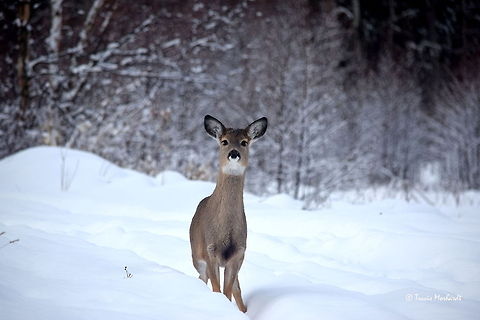
Reproduction
Females enter estrus, colloquially called the rut, in the autumn, normally in late October or early November, triggered mainly by the declining photoperiod. Sexual maturation of females depends on population density, as well as the availability of food. Young females often flee from an area heavily populated with males. Some does may be as young as six months when they reach sexual maturity, but the average age of maturity is 18 months. Copulation consists of a brief copulatory jump.Females give birth to one to three spotted young, known as fawns, in mid-to-late spring, generally in May or June. Fawns lose their spots during the first summer and weigh from 20 to 35 kg by the first winter. Male fawns tend to be slightly larger and heavier than females. For the first four weeks, fawns are hidden in vegetation by their mothers, who nurse them four to five times a day. This strategy keeps scent levels low to avoid predators. After about a month, the fawns are then able to follow their mothers on foraging trips. They are usually weaned after 8–10 weeks, but cases have been seen where mothers have continued to allow nursing long after the fawns have lost their spots as seen by rehabilitators and other studies. Males leave their mothers after a year and females leave after two.
Bucks are generally sexually mature at 1.5 years old and begin to breed even in populations stacked with older bucks.
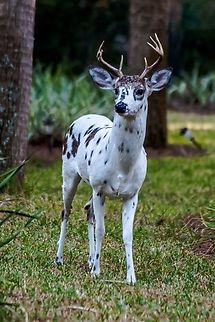
Food
White-tailed deer eat large amounts of food, commonly eating legumes and foraging on other plants, including shoots, leaves, cacti, prairie forbs, and grasses. They also eat acorns, fruit, and corn. Their multi-chambered stomachs allow them to eat some foods humans cannot, such as mushrooms, and poison ivy. Their diets vary by season according to the availability of food sources. They also eat hay, grass, white clover, and other foods they can find in a farmyard. Though almost entirely herbivorous, white-tailed deer have been known to opportunistically feed on nesting songbirds, field mice, and birds trapped in mist nets, if the need arises. When additional amounts of minerals such as calcium are needed in their diet, they can resort to osteophagy, chewing on bones of dead animals. A grown deer can eat around 900 kg of vegetable matter annually. A population of around 8 deer per square kilometre can start to destroy the forest environment in their foraging area.Their diet consists mostly of woody shoots, stems, and leaves of woody plants as well as grasses, cultivated crops, nuts, berries, and wildflowers. The items they feed on are not generally abundant in mature forests and are mostly found at "edges". Edges are described as a "mosaic of vegetation types that create numerous interwoven 'edges' where their respective boundaries intersect" and provide optimum cover for browsers such as the white-tailed deer. White-tailed deer can easily thrive in suburban areas, as a combination of increased safety from some predators, high quality and abundance of foods in home gardens, city parks, open farmland, and other factors all create landscapes with an abundance of edge habitat.
The white-tailed deer is a ruminant, which means it has a four-chambered stomach. Each chamber has a different and specific function that allows the deer to eat a variety of different foods, digesting it at a later time in a safe area of cover. The stomach hosts a complex set of microbes that change as the deer's diet changes through the seasons. If the microbes necessary for digestion of a particular food are absent, it will not be digested. Utilizing foregut fermentation, the fermented ingesta is regurgitated and chewed again, to mix it with saliva and reduce the particle size. Smaller particle size allows for increased nutrient absorption and the saliva is important because it provides liquid for the microbial population, recirculates nitrogen and minerals, and acts as a buffer for the rumen pH.White-tailed deer have long been hunted as game, for pure sport and for their commodities, and is probably the most hunted native big game species in the Americas. In Mesoamerica, white-tailed deer were hunted from very early times. Rites and rituals in preparation for deer hunting and celebration for an auspicious hunt are still practiced in the area today. Ancient hunters ask their gods for permission to hunt, and some deer rites take place in caves.
Venison, or deer meat, is a nutritious form of lean animal protein. In some areas where their populations are very high, white-tailed deer are considered a pest, and hunting is used as a method to control them.
In 1884, one of the first hunts of white-tailed deer in Europe was conducted in Opočno and Dobříš, in what is now the Czech Republic. In the same era, white-tailed deer were hunted to near extinction in North America, but numbers have since rebounded to approximate pre-colonization levels. In the United States, whitetail hunting is far more popular in some states than others. The top five states for whitetail hunter concentrations are all in the Northeast and Midwest. The Northeast in particular has twice the hunter density of the Midwest and Southeast and ten times that of the West.
Since whitetail deer is very adaptable, inhabiting diverse regions ranging from tropical rain forests to high-altitude mountain chains of the Andes Mountains at more than 13,000 feet, different hunting methods as well as types of guns and ammo may be used. Most common cartridges used include the.243 Winchester,.308 Winchester,.25-06 Remington,.270 Winchester, 7mm Remington Magnum,.30-06 Springfield,.300 Winchester Magnum and 12 gauge shotshells. Due to the whitetail deer's frame and weight, cup and core bullets are the most recommended for taking clean, ethical shots.
Sport hunting for whitetail deer is a way of conservation of natural habitats as well as a population management.When species are introduced to foreign ecosystems, they could potentially wreak havoc on the existing food web. For example, when the deer moved north in Alberta, gray wolf populations increased. This butterfly effect was also demonstrated in It is also possible that the increasing white-tailed deer populations could result in them becoming an invasive species for various plants in Alberta, Canada.
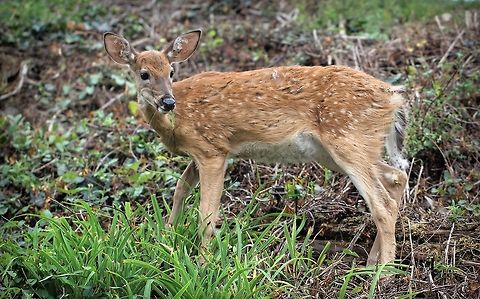
Predators
There are several natural predators of white-tailed deer, with wolves, cougars, American alligators, jaguars and humans being the most effective natural predators. Aside from humans, these predators frequently pick out easily caught young or infirm deer, but can and do take healthy adults of any size. Bobcats, Canada lynx, grizzly and American black bears, wolverines, and packs of coyotes usually prey mainly on fawns. Bears may sometimes attack adult deer, while lynxes, coyotes, and wolverines are most likely to take adult deer when the ungulates are weakened by harsh winter weather. Many scavengers rely on deer as carrion, including New World vultures, raptors, red and gray foxes, and corvids. Few wild predators can afford to be picky and any will readily consume deer as carrion. Records exist of American crows and common ravens attempting to prey on white-tailed deer fawns by pecking around their face and eyes, though no accounts of success are given. Occasionally, both golden and bald eagles may capture deer fawns with their talons. In one case, a golden eagle was filmed in Illinois unsuccessfully trying to prey on a large mature white-tailed deer.White-tailed deer typically respond to the presence of potential predators by breathing very heavily and fleeing. When they blow, the sound alerts other deer in the area. As they run, the flash of their white tails warns other deer. This especially serves to warn fawns when their mother is alarmed. Most natural predators of white-tailed deer hunt by ambush, although canids may engage in an extended chase, hoping to exhaust the prey. Felids typically try to suffocate the deer by biting the throat. Cougars and jaguars will initially knock the deer off balance with their powerful forelegs, whereas the smaller bobcats and lynxes will jump astride the deer to deliver a killing bite. In the case of canids and wolverines, the predators bite at the limbs and flanks, hobbling the deer, until they can reach vital organs and kill it through loss of blood. Bears, which usually target fawns, often simply knock down the prey and then start eating it while it is still alive. Alligators snatch deer as they try to drink from or cross bodies of water, grabbing them with their powerful jaws and dragging them into the water to drown.
Most primary natural predators of white-tailed deer have been essentially extirpated in eastern North America, with a very small number of reintroduced critically endangered red wolves, around North Carolina and a small remnant population of Florida panthers, a subspecies of the cougar. Gray wolves, the leading cause of deer mortality where they overlap, co-occur with whitetails in northern Minnesota, Wisconsin, Michigan, and most of Canada. This almost certainly plays a role in the overpopulation issues with this species. Coyotes, widespread and with a rapidly expanding population, are often the only major nonhuman predator of the species in the Eastern U.S., besides an occasional domestic dog. In some areas, American black bears are also significant predators. In north-central Pennsylvania, black bears were found to be nearly as common predators of fawns as coyotes. Bobcats, still fairly widespread, usually only exploit deer as prey when smaller prey is scarce. Discussions have occurred regarding the possible reintroduction of gray wolves and cougars to sections of the eastern United States, largely because of the apparent controlling effect they have through deer predation on local ecosystems, as has been illustrated in the reintroduction of wolves to Yellowstone National Park and their controlling effect on previously overpopulated elk. However, due to the heavy urban development in much of the Eastern U.S., and fear for livestock and human lives, such ideas have ultimately been rejected by local communities and/or by government services and have not been carried through.
In areas where they are heavily hunted by humans, deer run almost immediately from people and are quite wary even where not heavily hunted.
White-tailed deer can run faster than their predators and have been recorded sprinting at speeds of 60 km per hour and sustaining speeds of 50 km per hour over distances of 5–6 km; this ranks them amongst the fastest of all deer, alongside the Eurasian roe deer. They can also jump 3 m high and up to 9 m forward. When shot at, a white-tailed deer will run at high speeds with its tail down. If frightened, the deer will hop in a zig-zag with its tail straight up. If the deer feels extremely threatened, however, it may choose to attack, charging the person or predator posing the threat, using its antlers or, if none are present, its head to fight off its target.
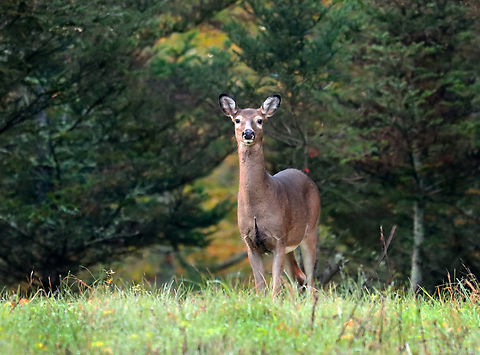
Migration
Climate change is affecting the white-tailed deer by changing their migration patterns and increasing their population size. This species of deer is restricted from moving northward due to cold harsh winters. Consequently, as climate change warms up the Earth, these deer are allowed to migrate further north which will result in the populations of the white-tailed deer increasing. Between 1980 and 2000 in a study by Dawe and Boutin, presence of white-tailed deer in Alberta, Canada was driven primarily by changes in the climate. Populations of white-tailed deer have also moved anywhere from 50 to 250 km north of the eastern Alberta study site. Another study by Kennedy-Slaney, Bowman, Walpole, and Pond found that if our CO2 emissions remained the same, global warming resulting from the increased greenhouse gases in our atmosphere will allow white-tailed deer to survive further and further north by 2100. This study also showed that an increase in deer populations will affect populations of other species.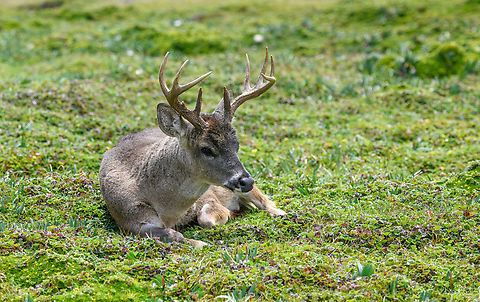
Cultural
In the U.S., the species is the state animal of Arkansas, Georgia, Illinois, Michigan, Mississippi, Nebraska, New Hampshire, Ohio, Pennsylvania, and South Carolina, the game animal of Oklahoma, and the wildlife symbol of Wisconsin. The white-tailed deer is also the inspiration of the professional basketball team the Milwaukee Bucks. The profile of a white-tailed deer buck caps the coat of arms of Vermont and can be seen in the flag of Vermont and in stained glass at the Vermont State House. It is the national animal of Honduras and Costa Rica and the provincial animal of Canadian Saskatchewan and Finnish Pirkanmaa. It appears on the reverse side of the Costa Rican 1,000 colón note. The 1942 Disney film adaptation of "Bambi", famously changed Bambi's species from the novel's roe deer into a white-tailed deer.References:
Some text fragments are auto parsed from Wikipedia.
